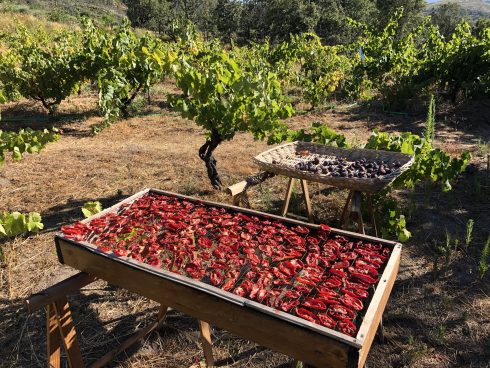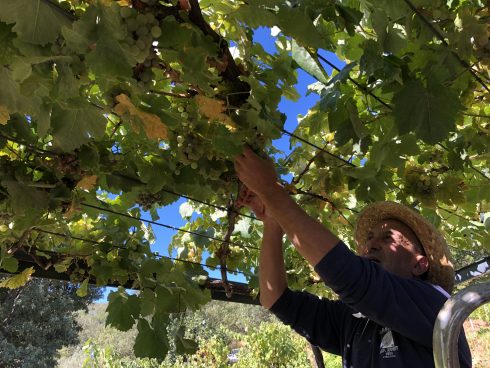In the latest serialisation of seasoned travel writer Paul Richardson’s new book, Hidden Valley, he reveals how he prepares his favourite late-summer treats with the help of an abundance of ripe fruit and veg in the hills of Extremadura…
THE simplicity of late-summer eating, the sensuousness of it and the concentrated taste of produce at a pitch of ripeness: figs, nectarines, melon, pears.
The balm of an ice-cold salmorejo, silky with oil and piquant with garlic. Yellow figs, intensely sweet, with thin slices of ham. A Russian salad made with cooked carrots and peas, potatoes and a little onion and a boiled egg, all of it diced and bound together with homemade mayonnaise.
Hunger comes at odd times of the day and night. I’ve taken to eating at five in the afternoon and sleeping until eight. For lunch today, my summer staple: linguine with a raw tomato sauce. For midnight supper a thin fillet of our own pork, a scatter of oregano, pepper and salt sizzled on the griddle and sliced into strips.
Just beside the stove stands a bowl with the remains of the grated raw tomato from lunch, ready seasoned with fresh basil and olive oil, so I slide the red slick on to the hot pan, push it around a bit, et voilà, an instant sauce for my pork steak.
Struggling to eat the fruit that now arrives in baffling quantities. Pears that are green and hard and then turn yellow, aromatic and juicy. (I’ve taken to drying them in slices out in the sun, on the chicken-wire rack we use for sun-drying tomatoes.)

Strawberries, smaller and smaller as the season progresses but more and more strongly perfumed, to the point that a cloud of strawberry smell bursts out from the fridge when you open the door. Japanese nashi, shaped like apples but tasting more like pears, with a pellucid crispness to their pearly flesh. Small yellow peaches, good to eat but even better peeled, sliced and bottled in syrup for the winter. Cantaloupe melons, the round ones with the orange flesh, gloriously perfumed, the best of all possible breakfast foods.
The pig gets all the peelings and pips. Meanwhile the fire has retreated from the forefront of my consciousness. This morning on my early rounds I catch myself thinking: How can a landscape be so ravaged, so damaged, and still retain its loveliness? Yet it does. The surface may be temporarily scarred, but the lie of the land, its shape, its soul, can’t be touched.
As the sun came up I walked out of the house and away to the edge of the forest. From here there was a view that filled up my senses always, the land falling away towards the stream, the valley holding the village clustered around the church as if in cupped hands, and sometimes a big horizontal brushstroke of snow tinted rose-pink on the distant peaks.
All around me lay the vineyard. A faint dew had fallen overnight, moistening the leaves. Trailing fronds of grapevine reached out to touch each other, their leaves having lost their sprightly greenness and begun to turn brownish yellow and redden around the edges, as if the lifeforce was now being diverted away from the plant itself and into the swelling fruit.
I liked the way the vines surrounded the house, hugging it protectively, gently bobbing like a lake of green. At any time of year they were worthy of my attention. The black, wrinkled stumps standing mute and unflinching in a winter downpour had an air of something mineral rather than vegetable, as if carved out of black volcanic basalt.
In April the buds burst into delicate shoots, which unfurled into tiny leaves and grew tiny clusters of green pinheads: embryo grapes. One vine on its own was a lonely thing, but a large number of them was a magical collective entity, sprouting and fruiting as one, branches moving in the breeze like a single organism.
Baudilio, the old man who had worked this land for half a century, once told me his father had first laid out the vineyard nearly a century ago, planting it with vine cuttings brought from an important winemaking region far from here where he regularly worked the grape harvest. Baudilio had more vine- yards around the village and a bar in the main street serve glasses of his strong, pungent white wine.

In springtime he ploughed between the rows with a plough drawn by the family mule, which lived in the hut that would eventually become my bedroom. What no one could tell me, not even he, were the grape varieties. In the old days nobody much worried about such things; varietal identity is a modern obsession.
There was white and there was red, and these were mostly white, with an occasional red one popping up randomly in the midst of them. The wines we had tasted in the village bars were white, but strong and sometimes slightly oxidised or sherry-ish, and surprisingly pallid in colour.
They were fermented and stored in big-bellied clay urns or vats, which made the cellars of village houses look like a set for Ali Baba and the Forty Thieves. The vats were treated inside with a resin derived from pine sap to seal and disinfect the clay, which often gave the wines a hint of the balsamic piney taste you find, much more prominently, in Greek retsina.
The idea was appealing to me: I imagined a link, over huge distances of time and space, between the amphoras of Attica and the clay vats of this village in twenty-first-century Spain.
READ MORE:
- Click here to read the first extract
- Click here to read the second extract
- Click here to read an interview with Paul











